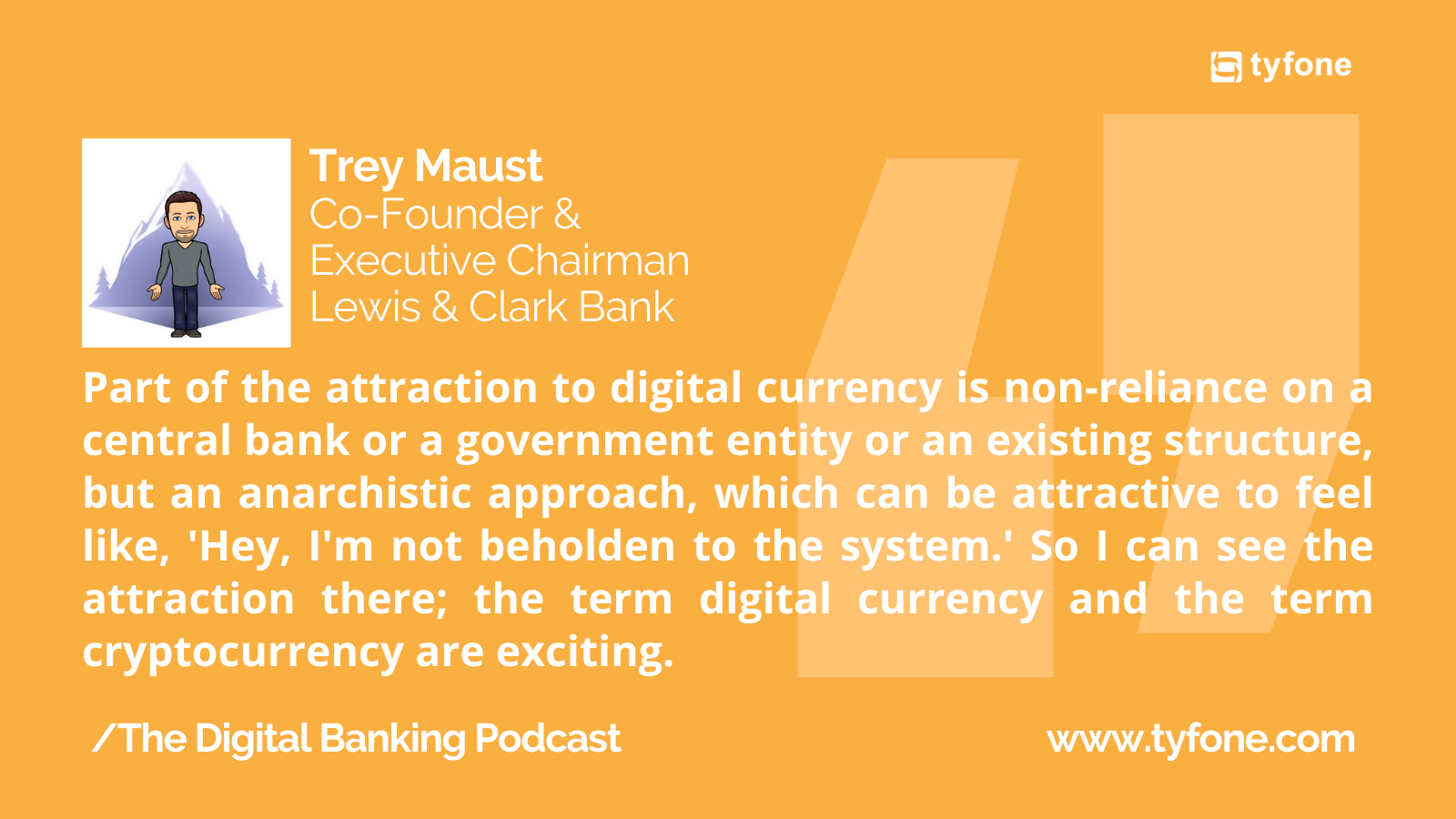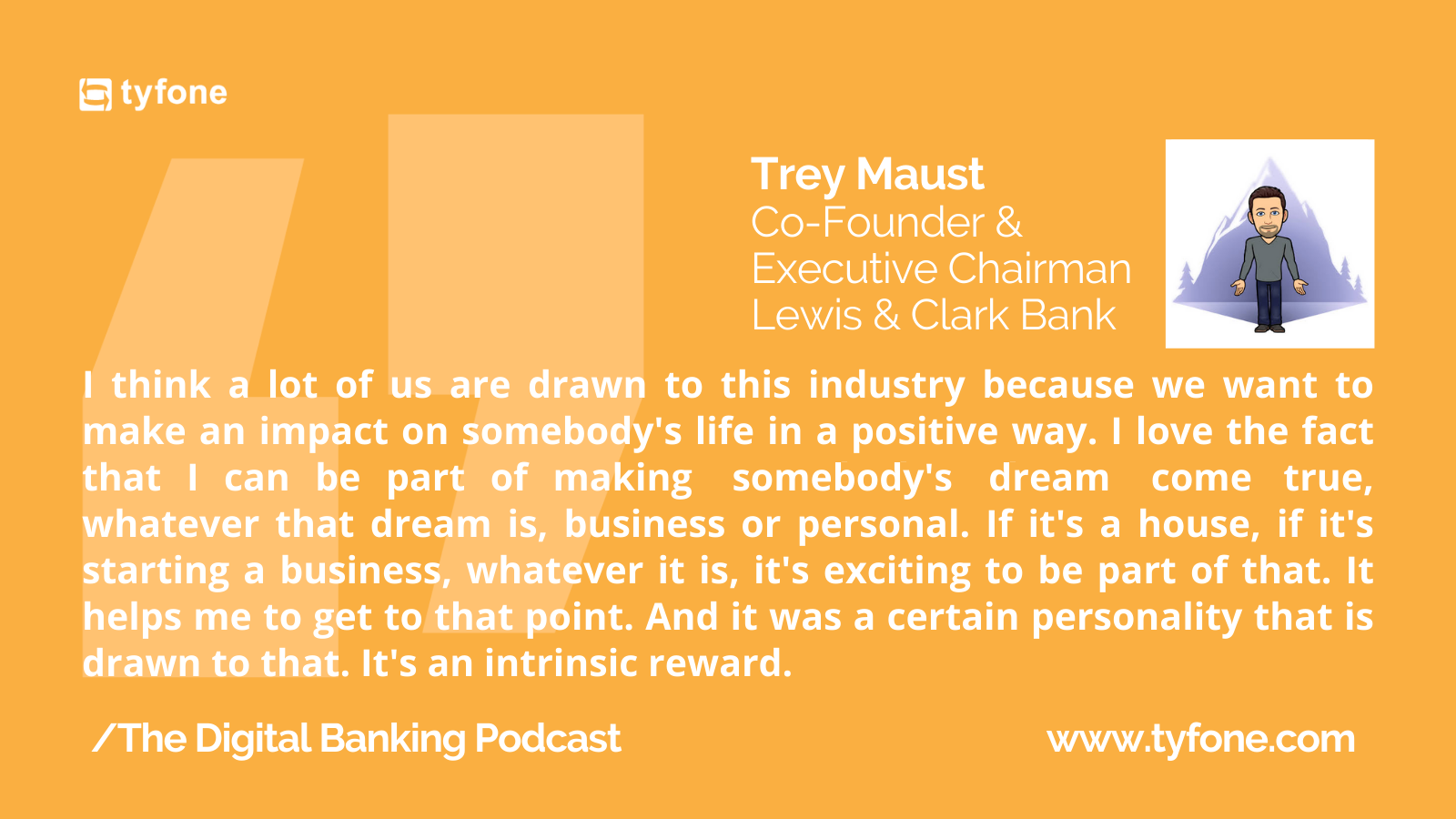Community FIs Have an Edge

Trey Maust
Co-Founder & Executive Chairman
- Community financial institutions (CFIs) are customer-focused. They are in direct touch with the community, helping people accomplish their financial goals.
- CFIs are not necessarily the innovators of financial technology. Their primary role is to keep money safe for their customers.
- Although CFIs don’t develop innovative technology on their own, they need to constantly stay aware of those innovations and leverage them as appropriate to stay relevant. Otherwise, they’ll lose business to other CFIs that are smarter with technology.
Trey Maust is the Co-Founder and currently the Executive Chairman of Lewis & Clark Bank, an entrepreneurial local community bank focused primarily on businesses and nonprofits. Trey has over twenty-five years of experience in banking, capital markets, and financial services. Prior to founding a bank, he served as a CEO and Director in several companies. He’s knowledgeable and quite passionate about the banking industry and community financial institutions.
In this episode of the Digital Banking Podcast, host Josh DeTar and Trey discuss the emerging trends in the financial sector. They talk about the role that financial institutions could play in the future of banking if they learn how to leverage their strengths to power fintech.

The enormous advantage of community financial institutions: They put the community first
As the name suggests, community financial institutions are focused on the community. Building relationships with their customers is at the very core of their business. Interestingly enough, the type of customers that CFIs attract is also their greatest strength. Trey talks about the recession that hit two years after he co-founded the Lewis & Clark Bank. Though very challenging for the bank, this experience showed the value of community.
Trey explains, “That was an incredible learning experience in a very painful way. But the bank survived because of the credit underwriting and the types of customers and borrowers we had. We had almost no credit losses throughout the entire recession and for the years after, as well. It’s just a testament to the type of customers that I think CFIs bring to the table and the character elements, as opposed to just looking at the quantitative numbers.”
CFIs have a unique opportunity to harness that community focus and use it as a competitive advantage. Large corporations are managed by committees whose decisions are made in a vacuum. They’re not in touch with the community and, therefore, are more process-oriented. According to Trey, the more a company grows, the less it can be in direct touch with the marketplace. On the other hand, CFIs care about the individuals and work closely with them to help them accomplish their financial goals.

Banking and fintech: Taking the best of both worlds
CFIs aren’t in the business of developing new technology. However, it’s imperative that they monitor, evaluate and leverage new technology for the maximum benefit of the people they serve. Trey explains why this is the case.
“If we look at, on a spectrum of risk, higher-risk takers versus very low-risk takers, banking certainly falls in the risk-averse camp. Those that work at banks, even founders of banks, tend to be in that category. So it draws people of those personality types to banking. At the same time and on the other side of the spectrum, we have the technology companies. We have founders of fintech. We have people thinking about, ‘Well, how could you do something?’ Well, maybe if we try this and throw it onto the marketplace, it might just work, and that’s okay. If it doesn’t, we can always try the next thing. You can’t do that in banking.”
There’s a valid reason why it’s difficult to start a bank. Banks are there to supervise, to ensure the business model is being executed and the money is kept safe. Still, customers are drawn to technology. They crave instant payments and technological advancements. The key is to allow for innovation to occur outside the industry. Banks need to help the innovators to scale by powering everything else in the financial system.
If financial institutions don’t power fintech, they risk being left out
Technological development is inevitable. The trick is to keep a balance between innovation and safety. Banks and fintechs have to work together. FIs can’t ignore the growth of technology. Instead, they need to embrace the innovators.
Looking at the cryptocurrency example, we see that innovation will inevitably happen outside of the financial sector. If FIs don’t provide a path for fintech companies to access the banking systems infrastructure, they will figure out a way around it. Trey says he wouldn’t want to see that happen again.
“We have an opportunity to take what we have built and what we do best, which is we have those elements I was talking about earlier of trust and confidence and always doing things right. But also, we know what we’re doing when it comes to moving money, safekeeping it, and making sure things always function the way they should. So we can provide that stability as banking infrastructure, as a service. And that’s something that I’ve become passionate about over the last year as being an opportunity for us as CFIs.”
Instant gratification: Are instant payments even possible?
Trey and Josh discuss another emerging trend: the culture of instant gratification. Customers continue to be drawn to technology platforms, and as a result, they’re becoming less patient. They don’t want to wait 5-7 working days to get their money transferred or processed. They expect it immediately.
“I think it’s when we try to compete with or say, ‘We don’t want to have anything to do with you,’ they’re going to figure out a way to get around it. To address your question about ‘Gee, why is it going to take three to five days to post?’ We can fix that pretty easily through credit where to you, it feels like it’s instant, but behind the scenes, each counterparty may be a business counterparty.”
Trey goes on to explain that it’s essential to give the optics of instant money movement and make it feel like it’s instant gratification to the customer when in reality, there are all these regulations being executed behind the scenes.
Digital currency is attractive, but doesn’t seem sustainable in the long run without supervisory oversight
Trey understands the attraction and excitement of digital currency. However, he also sees some problems with it—for instance, the matter of sustainability. Once again, Trey stresses the importance of letting innovation occur outside of the financial industry but not ignoring it.
“There are some problems, but it still is something that’s here to stay and will probably be converted into a more normalized use case at some point in the future. Again, I wouldn’t want to see us ignore digital currency and try to work around it because if we do that, we’ll be excluded from that debate and from participating in the future.”

